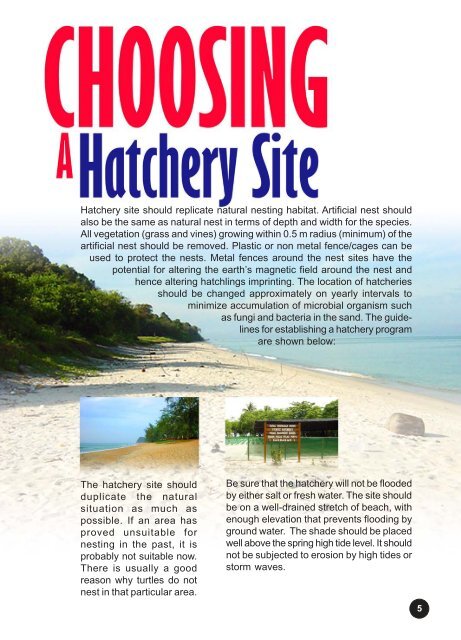Sea Turtle Hatchery - seafdec.org.my
Sea Turtle Hatchery - seafdec.org.my
Sea Turtle Hatchery - seafdec.org.my
You also want an ePaper? Increase the reach of your titles
YUMPU automatically turns print PDFs into web optimized ePapers that Google loves.
<strong>Hatchery</strong> site should replicate natural nesting habitat. Artificial nest should<br />
also be the same as natural nest in terms of depth and width for the species.<br />
All vegetation (grass and vines) growing within 0.5 m radius (minimum) of the<br />
artificial nest should be removed. Plastic or non metal fence/cages can be<br />
used to protect the nests. Metal fences around the nest sites have the<br />
potential for altering the earth’s magnetic field around the nest and<br />
hence altering hatchlings imprinting. The location of hatcheries<br />
should be changed approximately on yearly intervals to<br />
minimize accumulation of microbial <strong>org</strong>anism such<br />
as fungi and bacteria in the sand. The guidelines<br />
for establishing a hatchery program<br />
are shown below:<br />
The hatchery site should<br />
duplicate the natural<br />
situation as much as<br />
possible. If an area has<br />
proved unsuitable for<br />
nesting in the past, it is<br />
probably not suitable now.<br />
There is usually a good<br />
reason why turtles do not<br />
nest in that particular area.<br />
Be sure that the hatchery will not be flooded<br />
by either salt or fresh water. The site should<br />
be on a well-drained stretch of beach, with<br />
enough elevation that prevents flooding by<br />
ground water. The shade should be placed<br />
well above the spring high tide level. It should<br />
not be subjected to erosion by high tides or<br />
storm waves.<br />
5

















